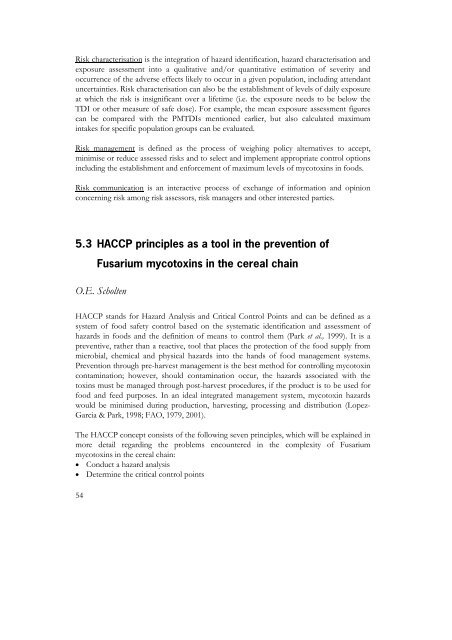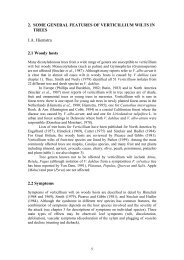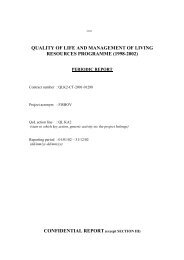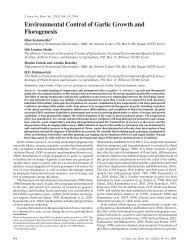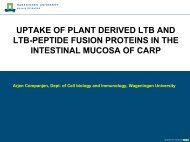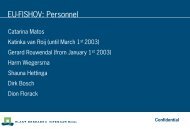3. Fusarium mycotoxins in cereals - Plant Research International ...
3. Fusarium mycotoxins in cereals - Plant Research International ...
3. Fusarium mycotoxins in cereals - Plant Research International ...
You also want an ePaper? Increase the reach of your titles
YUMPU automatically turns print PDFs into web optimized ePapers that Google loves.
Risk characterisation is the <strong>in</strong>tegration of hazard identification, hazard characterisation and<br />
exposure assessment <strong>in</strong>to a qualitative and/or quantitative estimation of severity and<br />
occurrence of the adverse effects likely to occur <strong>in</strong> a given population, <strong>in</strong>clud<strong>in</strong>g attendant<br />
uncerta<strong>in</strong>ties. Risk characterisation can also be the establishment of levels of daily exposure<br />
at which the risk is <strong>in</strong>significant over a lifetime (i.e. the exposure needs to be below the<br />
TDI or other measure of safe dose). For example, the mean exposure assessment figures<br />
can be compared with the PMTDIs mentioned earlier, but also calculated maximum<br />
<strong>in</strong>takes for specific population groups can be evaluated.<br />
Risk management is def<strong>in</strong>ed as the process of weigh<strong>in</strong>g policy alternatives to accept,<br />
m<strong>in</strong>imise or reduce assessed risks and to select and implement appropriate control options<br />
<strong>in</strong>clud<strong>in</strong>g the establishment and enforcement of maximum levels of <strong>mycotox<strong>in</strong>s</strong> <strong>in</strong> foods.<br />
Risk communication is an <strong>in</strong>teractive process of exchange of <strong>in</strong>formation and op<strong>in</strong>ion<br />
concern<strong>in</strong>g risk among risk assessors, risk managers and other <strong>in</strong>terested parties.<br />
5.3 HACCP pr<strong>in</strong>ciples as a tool <strong>in</strong> the prevention of<br />
54<br />
<strong>Fusarium</strong> <strong>mycotox<strong>in</strong>s</strong> <strong>in</strong> the cereal cha<strong>in</strong><br />
O.E. Scholten<br />
HACCP stands for Hazard Analysis and Critical Control Po<strong>in</strong>ts and can be def<strong>in</strong>ed as a<br />
system of food safety control based on the systematic identification and assessment of<br />
hazards <strong>in</strong> foods and the def<strong>in</strong>ition of means to control them (Park et al., 1999). It is a<br />
preventive, rather than a reactive, tool that places the protection of the food supply from<br />
microbial, chemical and physical hazards <strong>in</strong>to the hands of food management systems.<br />
Prevention through pre-harvest management is the best method for controll<strong>in</strong>g mycotox<strong>in</strong><br />
contam<strong>in</strong>ation; however, should contam<strong>in</strong>ation occur, the hazards associated with the<br />
tox<strong>in</strong>s must be managed through post-harvest procedures, if the product is to be used for<br />
food and feed purposes. In an ideal <strong>in</strong>tegrated management system, mycotox<strong>in</strong> hazards<br />
would be m<strong>in</strong>imised dur<strong>in</strong>g production, harvest<strong>in</strong>g, process<strong>in</strong>g and distribution (Lopez-<br />
Garcia & Park, 1998; FAO, 1979, 2001).<br />
The HACCP concept consists of the follow<strong>in</strong>g seven pr<strong>in</strong>ciples, which will be expla<strong>in</strong>ed <strong>in</strong><br />
more detail regard<strong>in</strong>g the problems encountered <strong>in</strong> the complexity of <strong>Fusarium</strong><br />
<strong>mycotox<strong>in</strong>s</strong> <strong>in</strong> the cereal cha<strong>in</strong>:<br />
• Conduct a hazard analysis<br />
• Determ<strong>in</strong>e the critical control po<strong>in</strong>ts


